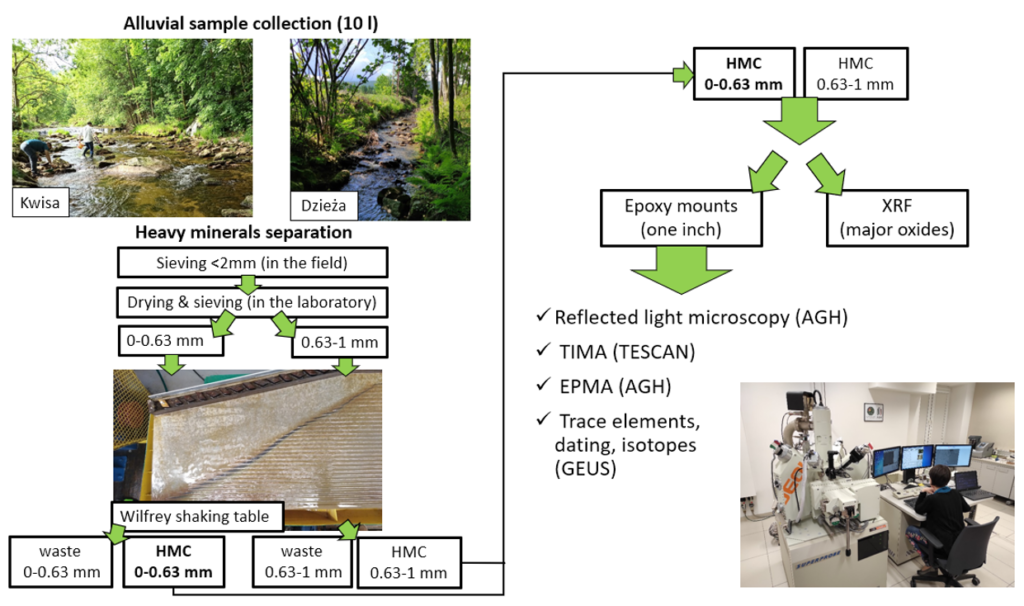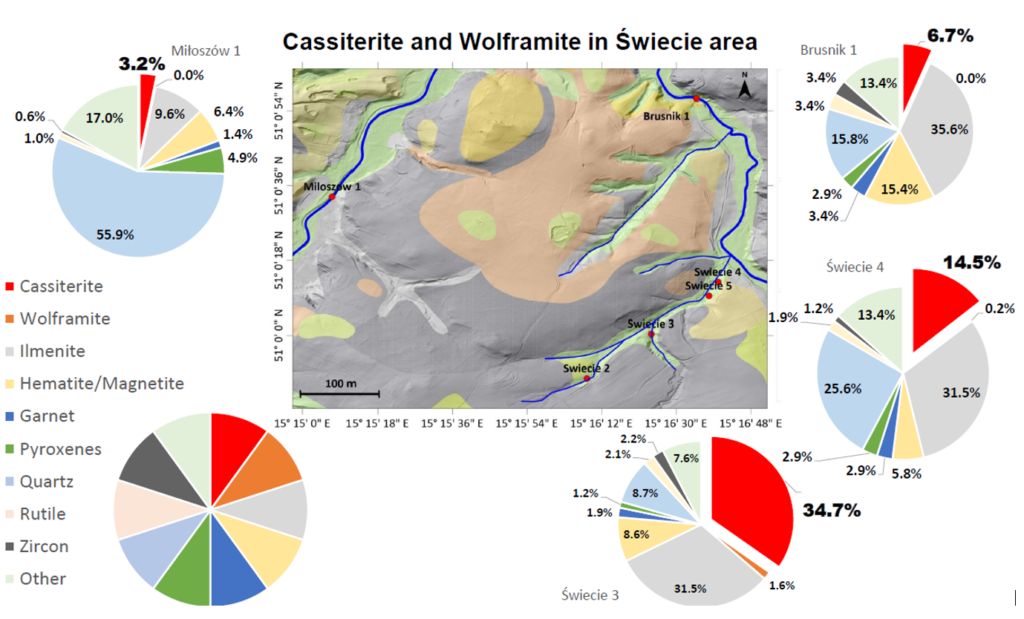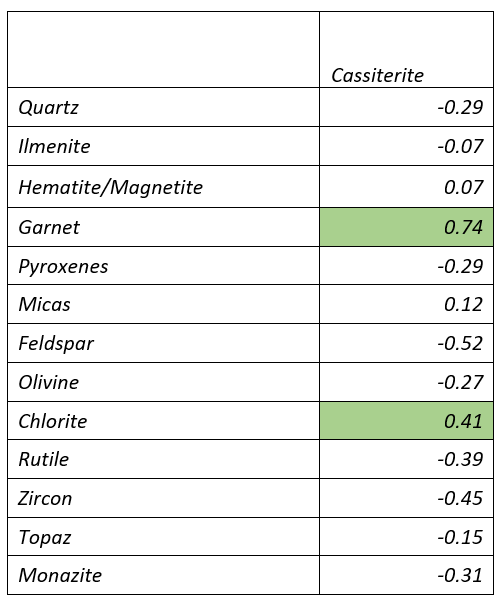Krzysztof Foltyn, Władysław Zygo
The Karkonosze-Izera Massif (KIM) in SW Poland has a complicated geological history, confirmed by new isotopic data obtained as part of MinExTarget project (Foltyn et al. 2023), which indicate that base metal mineralization could be tracked back to the Early Palaeozoic (Fig. 1). The same is true for tin mineralization, which was shaped by the interplay of hydrothermal, magmatic and metamorphic processes stretching over the entire Palaeozoic. Although this complexity provides additional challenges, it is also the exact reason why this specific area was chosen as one of the test sites for the MinExTarget project. It allows to examine the effectiveness and flexibility of the MinExTarget approach applied to heavy minerals concentrates obtained from river sediments.

Figure 1. Simplified geological map of the Karkonosze Izera Massif (KIM).
The main analytical tools used in this investigation were a TIMA-X automated mineralogy system (at TESCAN, Brno) to obtain quantitative data about mineralogical composition, microprobe (at AGH) for major elements and LA-ICP-MS (at GEUS) for trace elements and U-Pb geochronology of cassiterite and scheelite. This setup provides a wide range of tools that can be tailored/suited to specific geological settings and different types of mineralization (Fig. 2).

Figure 2. Scheme of Heavy Mineral Concentrate (HMC) preparation and analysis.
One of the simplest and most widely used methods in exploration is to collect chemical assays of stream sediments and follow the geochemical signatures of elements of interest upstream like crumbs of bread to find the source of anomaly. The same can be done with indicator minerals, in the case of KIM, these include among others cassiterite, scheelite and wolframite. Streams in the NW part of the test area provide an example of this approach: the amount of cassiterite steadily increases upstream from 6.7% to up to 34.7% of heavy minerals in concentrate, while in the case of wolframite, its share grows from 0.0 to 1.6% (Fig. 3).

Figure 3. Mineral distribution in HMC from Świecie area.
It’s just a tip of an iceberg of valuable information which can be inferred about primary mineralization based on heavy minerals concentrates from river sediments, key for more efficient and successful mineral exploration.
In the case of KIM, simple correlation calculations between heavy minerals abundances indicate the link between cassiterite, garnet and chlorite which, in conjunction with knowledge about regional geology, clearly indicate that the Stara Kamienica Schist Belt, consisting of mica-quartz-chlorite schist with garnets, is indeed the lithological unit hosting primary tin mineralization (Table 1). Consequently Minextarget proves to have powerful targeting potential in cases where unknown primary mineralization is hosted in lithologies containing specific suites of heavy minerals transported by rivers and streams (Fig. 4).

Table 1. Multiple correlation coefficients between cassiterite and minerals in HMC.

Figure 4. Mineral composition of HMC from study area obtain from automated mineralogy (TIMA).
Trace element compositions of cassiterite depend on temperature, redox conditions, pH and source of hydrothermal fluids. These parameters usually vary among genetic types of tin deposits, therefore trace elements of cassiterite can be utilized to discriminate among them or at least rule out some genetic types as sources. For example, in the case of cassiterites from placers in the KIM, trace element data indicate that they have not come from pegmatite or greisen mineralization and are most likely related to a broad category of hydrothermal tin deposits, linked to quartz veins or skarn mineralization.
New geochronological data obtained for cassiterite from the KIM alone do not help refine the understanding of the geological evolution of this unit but when paired with trace elements unequivocally link placers and primary tin mineralization. Investigation conducted as part of the MinExTarget project revealed that tin placers in the Świecie area are Early Palaeozic and coeval with the Izera Gneiss protolith. On the other hand, U-Pb geochronology do not confirm a link between the bulk of tin mineralization in the Stara Kamienica Schist Belt with either a Izera Gneiss protolith or the younger Karkonosze Granite. Instead, results obtained fall into the timeframe of maximum metamorphic conditions, 40-20 Ma prior to the Variscan granitoid intrusions in Western Sudetes. While we cannot rule out the possibility that metamorphic processes could be involved in formation of the mineralization, it seems more likely that the cassiterite ages were reset during metamorphism and that they in fact represent older mineralization. It would explain some of the peculiar features of cassiterite crystals such as characteristic grape-like shape, translucent/white colour and white/translucent internal reflections.
Each of these pieces of information, spatial and temporal distribution, deposit type, and lithology of the host are important to guide exploration and this KIM test site was a prime example of how all of this information can be obtained from heavy mineral concentrates. This demonstrates how powerful the MinExTarget approach and service can be. These services are not generic, limited to specific deposit type but are flexible, and can be tailor-made; a true Swiss army knife for exploration, useful for a diverse set of commodities and geological settings.
References:
Foltyn K., Kozub-Budzyń G.A., Lahaye Y., Piestrzyński A., Skirak P., Zygo W., Pieczonka J. – Mineralogy and in situ S and Pb isotope characteristics of ore minerals from polymetallic mineralization in the Gierczyn-Przecznica area, SW Poland, Geological Quarterly Vol 67, No 1 (2023) 67: 10, doi: 10.7306/gq.1680



